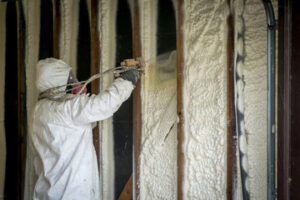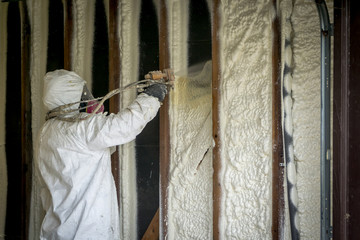Closed-cell spray foam insulation fills gaps and cracks that other types of insulation can’t, saving energy. Spray Foam Insulation Houston also helps deter moisture that leads to mold and mildew.
 Traditional spray foam uses isocyanates, which have a high GWP. New spray foams use hydrofluoroolefin blowing agents that have a lower GWP. Unlike wood studs or plywood, spray foam is non-reusable and will end up in landfills when it’s no longer useful.
Traditional spray foam uses isocyanates, which have a high GWP. New spray foams use hydrofluoroolefin blowing agents that have a lower GWP. Unlike wood studs or plywood, spray foam is non-reusable and will end up in landfills when it’s no longer useful.
Cost
The cost of spray foam insulation varies depending on the type of home and area being insulated. The amount of material required for each wall, ceiling, or floor also affects the price of the job. In addition, there are other factors to consider, including the number of areas being insulated and the installation method used. A top-rated pro can give you a free, no-commitment project estimate.
The costs of spray insulation are higher than other types, but it has a high energy efficiency and provides a sound barrier, so it is worth the investment for most homeowners. It is especially beneficial in areas where drafts are common and heating and cooling bills are expensive. The energy savings from a properly air-sealed attic will make up for the initial investment in just a few years.
Spray foam can be installed in new construction homes or in existing walls and attics. It is also used under exterior house siding and in crawl spaces and attic joists to help prevent moisture damage. Its thick layer of polyurethane insulation helps block heat, cold, and moisture from entering the home. It can be sprayed between attic rafters and under roof decks to seal gaps and create a more efficient space.
Unlike fiberglass batt insulation, spray foam can be applied in a single layer to fill wall cavities and studs. The foam is sprayed at a high pressure to ensure that the walls are evenly covered. One inch of foam provides an R-value of about R3.5, which is the same as a standard fiberglass batt. The cost of spray insulation is usually $44 to $150 per 100 square feet of wall space. This is less than half the cost of other types of insulation, including cellulose or rock wool blown in insulation.
Another advantage of spray insulation is that it has a lower environmental impact than other types. It contains no GWP (Global Warming Potential) and is made of recycled materials, such as denim and cotton. It is also more durable and less likely to mold than other types of insulation. It is important to hire a professional to install spray insulation, as it involves mixing dangerous chemicals at specific ratios and temperatures and requires training. A reputable insulation contractor can also help you choose the best material for your home and determine if you qualify for any rebates or incentives.
Energy Efficiency
Homeowners who have spray foam insulation installed in their homes can expect to save a significant amount on their energy bills. The reason is that this type of insulation effectively seals the air in the home, keeping conditioned and treated air inside and preventing outside air from entering. This greatly reduces the load placed on the HVAC system and significantly cuts electricity costs.
One important thing to note is that different types of insulation have different R-values. The higher the R-value, the more energy efficient the insulation is. Spray foam is able to achieve a high R-value due to its ability to fill small spaces and nooks and crannies where other forms of insulation cannot. This is why it is an ideal choice for basement rim joists, crawl spaces, attics, overhangs, knee walls and bonus rooms.
In addition to saving money on your utility bills, spray foam insulation also helps improve indoor air quality. This is because the airtight seal it creates makes it nearly impossible for airborne contaminants to make their way into the home. As a result, your HVAC air filters won’t get clogged as easily.
While the initial investment of having spray foam insulation installed in your home may seem a bit steep, it will quickly pay for itself. In fact, many homeowners see a return on their investment within just 3-5 years. This is because the reduced utility bills will more than make up for the initial cost of having the insulation installed.
Another benefit of using spray foam insulation is that it can help your home qualify for a green energy rating or an Energy Performance Certificate (EPC). The EPC is a legally valid document that provides information about a property’s energy efficiency. It also gives suggestions on ways that homeowners can improve their home’s energy efficiency and provide potential savings that they could make. It is worth checking with your local authorities to see if they offer any rebates or tax credits on home improvement projects that increase a house’s energy efficiency. If you are interested in having your home rated, contact a reputable spray foam insulation company to discuss the process.
Durability
The durability of spray foam insulation is one of its greatest benefits. It can last for the lifespan of a home or commercial building, making it an excellent investment. It also saves energy, making it a great choice for homeowners who want to reduce their energy bills. This type of insulation also offers other benefits, including reducing drafts and improving indoor air quality.
Spray polyurethane foam is made of two materials that combine to create a powerful insulator. These chemicals are kept in separate tanks until they’re sprayed, when they react with each other to form a foam solution. This product can be sprayed directly onto roof tiles, concrete slabs, walls, and into holes drilled into wall cavities. It’s available in varying densities, which determine its R-value, or thermal resistance rating, from about 3.2 to 6.5 per inch. It’s also available in different thicknesses, which vary the cost.
Another advantage of spray foam is its ability to seal cracks, gaps, and other nooks and crannies. The chemical compounds used in this type of insulation form tiny pockets of air, which make it difficult for heat or sound to pass through them. In addition, the foam can expand up to 30 times its liquid volume when it’s sprayed, so it can fill even the smallest gaps and spaces.
In new construction, spray foam can be installed in stud and rafter spaces by removing sections of drywall. In existing homes, the process is more complicated because installers must work around electrical wiring and ductwork. This can increase the cost of insulating an older house, but it’s still a cheaper alternative to replacing all the drywall in the home.
Spray foam is one of the most durable insulation products on the market, but it can have some problems with moisture and other issues that require professional attention. This is why it’s important to hire a top-rated pro to install this insulation in your home. They’ll ensure that the installation is done correctly, so you can enjoy long-term energy savings and comfort.
Installation
The initial cost of spray foam insulation is higher than fiberglass batts, but it pays for itself in as little as three years by lowering energy bills. It also offers a greater degree of thermal resistance than other types of insulation, and it can seal air leaks that contribute to high utility costs.
A top-rated professional can install spray foam insulation more quickly and more efficiently than a homeowner, which reduces the labor cost. Homeowners may be able to insulate small areas themselves, such as the areas around doors and windows, but larger jobs require a professional to do the job correctly.
Spray foam insulation consists of a liquid that expands in place to create a thick, dense barrier that prevents air leakage. It can be applied in various places, including the attic, walls, and floors. Its low cost and versatility make it a popular choice for homes in the US. However, it is important to choose an installer that uses a blowing agent with a low Global Warming Potential (GWP). There is also a medley of other options available, including cellulose and rock wool.
The main ingredient in spray foam is a petroleum-based chemical called isocyanate. It is derived from methylene diphenyl diisocyanate and emits a disturbing concoction of toxic gases, including carcinogens and bio-accumulative toxicants. Exposure to the chemicals can cause respiratory problems and other health issues, especially for those with preexisting asthma or other sensitivities.
Some homeowners prefer the insulating properties of spray foam, but others dislike the odor and the risk of skin irritations. If you are concerned about these factors, consider a cellulose or cotton insulation made with recycled paper. These alternatives contain few VOCs and do not off-gas as much.
The cost of spray insulation varies by area and thickness. The best way to find the right price for your project is to get quotes from several companies. Ask about their experience and the products they use. Some companies specialize in a particular area of the house, such as the attic or walls, while others offer general services for the entire home.
